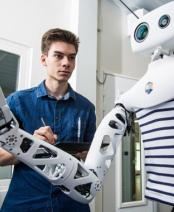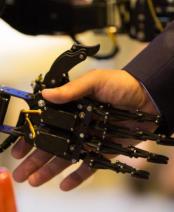Recherche

Research in the E4H Center spans the spectrum of highly fundamental studies all the way to applied and translational investigations. It also spans a wide spectrum of scales ranging from the molecular to the population level. Our research activities can be broadly categorized as follows:
Development of a fundamental quantitative understanding of living systems, including prokaryotes, and ranging from the molecular to the macroscopic scales. This includes biochemistry and biophysics of biomolecules, genomics and transcriptomics, basic principles in cell and developmental biology and biophysics, and systems biology and physiology.
Imaging molecules, cells, tissues, and whole organisms using a variety of imaging modalities including NMR, crystallography, and electron microscopy. A particular campus strength is the development of novel approaches in biophotonics and advanced optical imaging techniques (super-resolution, in-depth, high-throughput, and multimodal). Cellular/molecular imaging as well as genomic/proteomic studies generate large amounts of data, thereby creating considerable opportunities in data science, machine/deep learning, quantification, and analysis.
Multiscale modeling approaches focusing on molecular modeling of RNA and protein structure, in silico design of therapeutic molecules, and modeling of the structure and function of various organs and multi-organ systems in health and disease. In parallel, mathematical approaches in population dynamics are applied towards a predictive framework for the emergence of zoonoses and pathogen mutations.
Knowledge gained from the first three research directions above serves as a basis for translational activities in biomedical engineering. An example is the development of organ-on-chip/disease-on-chip systems that are used for designing therapeutic molecules/vaccines and for screening drugs. Particular emphasis is placed on emerging threats (e.g. viruses and antibiotic resistance) as well as personalized medicine (individual patient monitoring, ‘omic’ approaches, bioinformatics, machine learning, and predictive modeling). Synthetic biology, which encompasses methodologies from various disciplines including biophysics, chemical and biological engineering, and computer science, is used as a basis for designing new biological systems and interfacing with novel biomedical devices.















